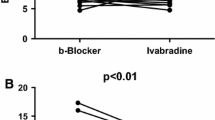Summary
Background: Clinical drawbacks of beta-blocker treatment in stable angina have motivated researchers to provide alternative heart rat lowering agents, such as tedisamil which additionally exerts antiischemic and antiarrhythmic effects by blockade of cellular repolarizing K+ currents.
Methods and Results: 48 patients with stable angina pectoris were investigated (double-blind, randomized, parallel grouped) comparing the hemodynamic, antiischemic, metabolic and neurohumoral effects of tedisamil 100 mg b.i.d and atenolol 50 mg b.i.d. after a single dose and over 6 days of treatment. Tedisamil and atenolol produced a decrease in heart rate both at rest (day 1: –13.6 vs –15.4 bpm; p > 0.05; day 6: –14.8 vs –22.2 bpm; resp.; p > 0.05) and exercise (day 1: –9.1 vs –18.3 bpm; p = 0.001; day 6: –12.0 vs –24.8 bpm, resp.; p = 0.001), while anginal threshold increased. Cardiac output decreased with tedisamil and atenolol at rest (day 1: –1.01 vs –1.19 l/min; p > 0.05; day 6: –0.86 vs –1.10 l/min, resp.; p > 0.05) and exercise (day 1: –0.82 vs –1.28 l/min; p > 0.05; day 6: –0.65 vs –2.68 l/min, resp.; p = 0.03), while stroke volume remained unchanged. Right atrial pressure changed during exercise only: It decreased with tedisamil (–1.7 mm Hg) and increased with atenolol (+3.7 mm Hg). Mean pulmonary capillary wedge pressures decreased at rest (–0.5 mm Hg) and exercise (–6.9 mm Hg) in the tedisamil group, but tended to increase with atenolol on day 6 (rest: +1.7; exercise: +3.7 mm Hg) (p = 0.03). Arterial pressure decreased under atenolol treatment only. Exercise-induced plasma norepinephrine levels were reduced by tedisamil (–93 pg/ml) but elavated by atenolol (+172 pg/ml) (p = 0.001). As compared to atenolol, tedisamil produced a significant prolongation of QT c interval (+31 vs –8 ms) (p = 0.002) at initial values of 0.408 ± 0.018 s with PQ and QRS remaining unaltered.
Conclusions: In the present study, tedisamil (100 mg b.i.d.) generated favorable hemodynamic, neurohumoral and antiischemic effects in patients with stable angina pectoris. The antiischemic efficacy of tedisamil, as measured by ST segment depression and angina threshold, is comparable to that of atenolol (50 mg b.i.d.).
Zusammenfassung
Klinische Limitationen bei der Behandlung der stabilen Angina pectoris mittels Betablocker führten zur Entwicklung von alternativen frequenzsenkenden Substanzen wie beispielsweise dem K+-Kanalblocker Tedisamil, der neben antiischämischen auch antiarrhythmische Eigenschaften aufweist. In der vorliegenden Untersuchung (doppelblinder, randomisierter Gruppenvergleich) wurden die hämodynamischen, antiischämischen, metabolischen und neurohumoralen Auswirkungen von 2× 100 mg Tedisamil und 2× 50 mg Atenolol als Monotherapie bei 48 Patienten mit stabiler Angina pectoris über einen Zeitraum von 6 Tagen verglichen. Tedisamil und Atenolol führten zu einer Senkung der Herzfrequenz sowohl in Ruhe (Tag 1: –14 vs –15 min-1; p > 0,05; Tag 6: –15 vs –22 min-1; p > 0,05) als auch unter Belastung (Tag 1: –9 vs –18 min-1; p = 0,001; Tag 6: –12 vs –25 min-1; p = 0,001) bei gleichzeitiger Erhöhung der Angina-pectoris-Schwelle. Das Herzzeitvolumen wurde unter beiden Substanzen sowohl in Ruhe (Tag 1: –1,01 vs –1,19 l/min; p > 0,05; Tag 6: –0,86 vs –1,01 l/min; p > 0,05) als auch unter Belastung (Tag 1: –0,82 vs –1,28 l/min; p > 0,05); Tag 6: –0,65 vs –2,68 l/min; p = 0,03) gesenkt, wobei das Schlagvolumen unverändert blieb. Der rechtsatriale Druck änderte sich nur unter Belastung mit einem Abfall unter Tedisamil (–1,7 mm Hg) und einem Anstieg unter Atenolol (+3,7 mm Hg) (p = 0,001). In der Tedisamil-Gruppe fiel der mittlere pulmonalkapilläre Verschlußdruck am 6. Behandlungstag sowohl in Ruhe (–0,5 mm Hg) als auch unter Belastung (–6,9 mm Hg), zeigte jedoch unter Atenolol eine Tendenz zum Anstieg (Ruhe: +1,7 mm Hg; Belastung: +3,7 mm Hg) (p = 0,03). Eine Senkung des arteriellen Druckes zeigte sich nur unter Behandlung mit Atenolol. Während die belastungsinduzierten Noradrenalin-Plasmaspiegel nach Tedisamil-Gabe gesenkt wurden (–93 pg/ml), zeigte sich unter Atenolol eine Erhöhung (+172 pg/ml) (p = 0,001). Nach Tedisamil fand sich eine im Vergleich zu Atenolol signifikante Verlängerung des QTc-Intervalls (+31 vs –8 ms) 8p = 0,002) bei einem Ausgangswert von 0,408 ± 0,018 und unveränderten PQ- und QRS-Zeiten. In der vorliegenden Studie zeigte Tedisamil günstige hämodynamische, metabolische und neurohumorale Effekte bei Patienten mit stabiler Angina pectoris. Die antiischämische Wirkung von Tedisamil, gemessen an der ST-Strecken-Senkung und der Angina-pectoris-Schwelle, ist mit der von Atenolol vergleichbar.
Similar content being viewed by others
Author information
Authors and Affiliations
Additional information
Eingegangen: 23. März 1999, Akzeptiert: 11. Juni 1999
Rights and permissions
About this article
Cite this article
Mitrovic, V., Miskovic, A., Straub, M. et al. Auswirkungen des K+-Kanalblockers Tedisamil auf Hämodynamik, Myokardischämie und neurohumorales System bei Patienten mit stabiler Angina pectoris.¶Ein Vergleich mit dem β-Blocker Atenolol. Z Kardiol 88, 838–849 (1999). https://doi.org/10.1007/s003920050360
Issue Date:
DOI: https://doi.org/10.1007/s003920050360




